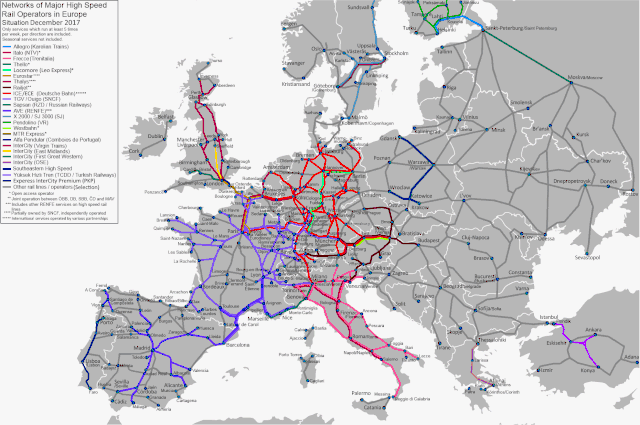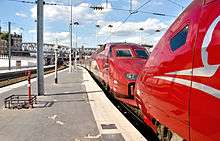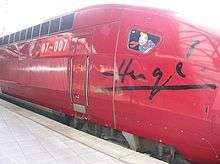Thalys
 | |
|
| |
| Overview | |
|---|---|
| Franchise(s) |
International joint operation service began 1996 |
| Main station(s) |
Paris Nord, Bruxelles Midi/Brussel Zuid, Köln Hauptbahnhof, Amsterdam Centraal |
| Other station(s) | Antwerpen-Centraal, Liège-Guillemins, Aachen Hauptbahnhof, Albertville, Bourg-St-Maurice, Lille Europe, Moûtiers, Chambéry-Challes-les-Eaux, Schiphol, Rotterdam Centraal |
| Fleet size |
9[1] Thalys PBA sets 17 Thalys PBKA sets |
| Stations called at | 26 |
| Parent company | SNCF, SNCB/NMBS |
| Website |
www |
| Thalys route map | ||||||||||||||||||||||||||||||||||||||||||||||||||||||||||||||||||||||||||||||||||||||||||||||||||||||||||||||||||||||||||||||||||||||||||||||||||||||||||||||||||||||||||||||||||||||||||||||||||||||||||||||||||||||||||||||||||||||||||||||||||||
|---|---|---|---|---|---|---|---|---|---|---|---|---|---|---|---|---|---|---|---|---|---|---|---|---|---|---|---|---|---|---|---|---|---|---|---|---|---|---|---|---|---|---|---|---|---|---|---|---|---|---|---|---|---|---|---|---|---|---|---|---|---|---|---|---|---|---|---|---|---|---|---|---|---|---|---|---|---|---|---|---|---|---|---|---|---|---|---|---|---|---|---|---|---|---|---|---|---|---|---|---|---|---|---|---|---|---|---|---|---|---|---|---|---|---|---|---|---|---|---|---|---|---|---|---|---|---|---|---|---|---|---|---|---|---|---|---|---|---|---|---|---|---|---|---|---|---|---|---|---|---|---|---|---|---|---|---|---|---|---|---|---|---|---|---|---|---|---|---|---|---|---|---|---|---|---|---|---|---|---|---|---|---|---|---|---|---|---|---|---|---|---|---|---|---|---|---|---|---|---|---|---|---|---|---|---|---|---|---|---|---|---|---|---|---|---|---|---|---|---|---|---|---|---|---|---|---|---|---|---|---|---|---|---|---|---|---|---|---|---|---|---|---|---|---|
| ||||||||||||||||||||||||||||||||||||||||||||||||||||||||||||||||||||||||||||||||||||||||||||||||||||||||||||||||||||||||||||||||||||||||||||||||||||||||||||||||||||||||||||||||||||||||||||||||||||||||||||||||||||||||||||||||||||||||||||||||||||
Thalys (French: [talis]) is a French-Belgian high-speed train operator originally built around the LGV Nord high-speed line between Paris and Brussels. This track is shared with Eurostar trains that go from Paris, Brussels or Amsterdam to London via Lille and the Channel Tunnel and with French domestic TGV trains. Thalys serves Amsterdam (via the HSL-Zuid, a service part of NS International) and Cologne as well. Its system is managed by Thalys International (SNCF (62%), NMBS/SNCB (28%), and Deutsche Bahn (10%)) and operated by THI Factory (SNCF (60%), NMBS/SNCB (40%)).[2]
History
Before Thalys, there had been an express rail service between Paris and Brussels since 1924 on the train service l'Étoile du Nord. In the 1970s it connected the two cities in around 2 hours 30 minutes.
The decision to build a high-speed railway between Paris, Brussels, Cologne and Amsterdam was made in 1987. On 28 January 1993,[3] SNCF, SNCB/NMBS,[2] Nederlandse Spoorwegen and Deutsche Bundesbahn (which became part of Deutsche Bahn in 1994) signed an agreement to operate the axis jointly through the brand Thalys, and in 1995 Westrail International was created by the French and Belgian national railways to operate the services. On 4 June 1996 the first train left Paris using the LGV Nord until it reached Belgium, taking 2:07 hours to Brussels and 4:47 hours to Amsterdam.[4]
In 1997, the Belgian HSL 1 line, allowing 300 km/h and running from the French border to the outskirts of Brussels, was completed for service. On 14 December 1997 the first Thalys train from Paris to Brussels ran on the HSL 1, reducing travel time to 1:25 hours. At the same time service commenced to Cologne and Aachen in Germany, and Bruges, Charleroi, Ghent, Mons, Namur and Ostend in Belgium. On 19 December 1998 the Thalys Neige service started to the ski resorts of Tarentaise Valley and Bourg St. Maurice. In May 1999, the new high-speed line serving Charles de Gaulle Airport opened, and Thalys started direct services from the Airport to Brussels, including code sharing agreements with Air France, American Airlines and Northwest Airlines. On 28 November 1999, the company changed its name to Thalys International.
In 2000, Thalys started a daily Service between Brussels and Geneva. Thalys Soleil started offering direct connections to the Provence; initially to Valence, and extended to Avignon and Marseille in 2002. Service between Brussels and Cologne was improved in December 2002 when trains began running on the new HSL 2 in Belgium. In 2003, services started to Brussels International Airport and the Thalys Nuits d’Été service to Marne-la-Vallée. Deutsche Bahn purchased 10% of the company in 2007.[4]
Beginning 14 June 2009 the journey between Brussels and Cologne was shortened by 19 minutes when the new high speed line HSL 3 between Liège and Aachen opened using Deutsche Bahn's thrice-daily ICE trains running between Brussels and Frankfurt. HSL 3 was completed in 2007, but Thalys trains had not yet been equipped with the ETCS signalling equipment necessary to use the new line. After installation and testing, Thalys began operating on HSL 3 on 13 December 2009. For the same reasons, Thalys started operating on the HSL 4/HSL-Zuid high-speed line between Antwerp and Amsterdam 13 December 2009, two years after the line's construction.
Since 29 August 2011, one return journey to Cologne has been extended to Essen Hauptbahnhof,[5] and since 30 October 2011, one return journey to Brussels had been extended to Brussels National Airport.[6]
In June 2013, Deutsche Bahn stopped selling Thalys tickets, and began a plan to exit from Thalys capital.
Thalys has served Düsseldorf Airport station since the winter 2013 schedule went into effect.[7]
On 12 April 2014, Thalys started a regular service between Lille Europe and Amsterdam Centraal.
At the end of March 2015, Thalys dropped the Paris – Oostende and the Paris – Brussels – Mons – Charleroi – Namur – Liège routes, due to the lack of funding from the Belgian government.
On 30 March 2015, Thalys became a train company (named THI Factory), and operates since under its own train operator certificate.[8]
Starting from 13 December 2015, service in Germany is extended to Dortmund.
Routes

Beyond Brussels, the main cities Thalys trains reach are Antwerp, Rotterdam, Amsterdam, Liège, Aachen and Cologne. Trains to these destinations run partly on dedicated high-speed tracks, and partly on conventional tracks shared with normal-speed trains. The high-speed lines used by Thalys are HSL 1 between Paris and Brussels, HSL 4/HSL-Zuid between Antwerp and Amsterdam, and the HSL 2 and HSL 3 between Brussels and Aachen. For its seasonal operations within France, other high-speed lines are used.
Plans to continue the line past Cologne to Frankfurt had to be abandoned because the Thalys train sets are very inefficient under Germany's 15 kV electric system and thus unable to operate at full speed on the Cologne-Frankfurt high-speed rail line.[9]
Journeys from Brussels (Brussels-South) to Paris (Gare du Nord) are normally 1 hour, 22 minutes, for a distance of approximately 300 kilometres (190 mi). Peak speed is 300 km/h (186 mph) on a dedicated high-speed railway track which is electrified at 25 kV AC OHLE.
The ligne à grande vitesse (LGV) link with Charles de Gaulle Airport allowed Air France to withdraw its air service between Paris and Brussels; instead, Air France books seats on Thalys trains.[10] Thalys has been given the IATA designator 2H. This is used in conjunction with American Airlines and Delta Air Lines. American Airlines has a code sharing agreement with Thalys for rail service from Charles de Gaulle airport to Brussels-South. The airline alliance SkyTeam also has a code sharing agreement with Thalys for rail service connecting its hub Amsterdam Schiphol Airport with Antwerp-Centraal and Bruxelles Midi/Brussel Zuid. Indian carrier Jet Airways has formed a codeshare agreement with the Thalys rail service between Brussels and Paris.[11]
| Paris Nord | Bruxelles Midi | Liege | Aachen Hbf | Köln Hbf / Cologne | Düsseldorf Hbf | Duisburg Hbf | Dortmund Hbf | Amsterdam Centraal | Schiphol Airport | Rotterdam Centraal | Antwerpen Centraal | Lille Europe | |
|---|---|---|---|---|---|---|---|---|---|---|---|---|---|
| Paris Nord | X | 1h22min | 2h10min | 2h35 | 3h14min | 3h39min | 3h53min | 4h41min | 3h17min | 2h59min | 2h37min | 2h01min | N/A |
| Bruxelles Midi | 1h22min | X | N/A | 1h08min | 1h47min | 2h12min | 2h25min | 3h08min | 1h50min | 1h32min | 1h10min | N/A | 35min |
| Liege | 2h10min | N/A | x | 22min | 1h01min | 1h26min | 1h39min | 2h22min | x | x | x | x | x |
| Aachen Hbf | 2h35min | 1h08min | 22min | x | 36min | 1h08min | 1h19min | N/A | x | x | x | x | x |
| Köln Hbf / Cologne | 3h14min | 1h47min | 1h01min | 36min | x | 24min | 43min | N/A | x | x | x | x | x |
| Düsseldorf Hbf | 3h39min | 2h12min | 1h26min | 1h08min | 41min | x | 14min | N/A | x | x | x | x | x |
| Duisburg Hbf | 3h53min | 2h25min | 1h39min | 1h19min | 43min | 14min | x | N/A | x | x | x | x | x |
| Dortmund Hbf | 4h41min | 3h08min | 2h22min | N/A | N/A | N/A | N/A | N/A | x | x | x | x | x |
| Amsterdam Centraal | 3h17min | 1h50min | x | x | x | x | x | x | x | N/A | N/A | 1h12min | 2h35min |
| Schiphol Airport | 2h59min | 1h32min | x | x | x | x | x | x | N/A | x | N/A | 54min | 2h25min |
| Rotterdam Centraal | 2h37min | 1h10min | x | x | x | x | x | x | N/A | N/A | x | 32min | 1h54min |
| Antwerpen Centraal | 2h01min | N/A | x | x | x | x | x | x | 1h12min | 54min | 32min | x | 1h19min |
| Lille Europe | N/A | 35min | x | x | x | x | x | x | 2h35min | 2h25min | 1h54min | 1h19min | x |
Market
Thalys targets a passenger market in France, Belgium, the Netherlands and Germany.
The percentage of income coming from different routes[12] demonstrates on which routes the company is most used:
- Paris-Brussels: 55.6%
- Paris-Belgium (outside Brussels): 8.9%
- Paris-Belgium-Netherlands: 21.3%
- Paris-Belgium-Germany: 11.8%
- Others: 2.4%
52% of customers are from the leisure market; 48% from the business market.
A large segment of Thalys's total sales and income comes from the connection between Paris and Brussels.
Unlike many national train companies, Thalys does not allow children below 12 years old to travel alone.
Since 24 August 2010, there has been a supplement of €7 to Thalys (as well as other international high speed tickets) tickets bought at SNCB/NMBS ticket offices at train stations. This is due to a reduction of a sales fee paid by Thalys and Eurostar to the Belgian rail company.[13]
| 1996 | 1997 | 1998 | 1999 | 2000 | 2001 | 2002 | 2003 | 2004 | 2005 | 2006 | 2007 | 2008 | 2009 | 2010 | 2011 | 2012 | 2013 | |
|---|---|---|---|---|---|---|---|---|---|---|---|---|---|---|---|---|---|---|
| Passengers | 4.72[14] | 4.98[15] | 5.5[16] | 5.8[17] | 6.0[18] | 5.8[19] | 5.95[20] | 6.15[21] | 6.5[22] | 6.2[23] | 6.5[24] | 6.07[25] | 6.45[25] | 6.65[26] | 6.60[27] | 6.69[28] | ||
| Revenue | 60[29] | 115[30] | 190 | 220 | 266 | 294 | 310 | 301 | 318 | 335 | 363 | 364 | 392 | 382 | 432 | 470 | 479 | 487[31] |
All figures in millions. Revenue in millions of euro.
Accessibility
Thalys trains are wheelchair-accessible, with assistance of the train staff. Bicycles are not allowed on Thalys, unless disassembled or packed in special wrap. Folding bikes are allowed.[32]
Due to the departure of Deutsche Bahn, the distribution of Thalys tickets was discontinued by the railway on June 9, 2013. Tickets are still available on the train (25 euros surcharge), by phone at Thalys itself for the same periods as the Internet sales (see below), the French (SNCF), the Dutch (NS) and the Belgian State Railways (NMBS / SNCB), some travel agencies (also with surcharge) and on the Internet up to three months in advance.
At Cologne Central Station (in the building opposite the main entrance of the station) there has been a Thalys Store & More since October 22, 2012. It acts as a normal travel agency with the above restrictions and makes a surcharge even for own trains.
Further outlets of Thalys Store & More exist in the main station Aachen as well as beside the main station Düsseldorf (Bertha-von-Suttner-Platz, south entrance).
Thalys Lounge
Thalys operates its own lounges in Brussels, Cologne, Aachen and Paris. Opened on 9 July 2015, the newest lounge on Gare du Nord, located on Rue de Dunkerque, offers travelers with a valid Thalys the Card (Thalys Loyalty Program) a variety of services, including free WiFi or a luggage storage service. For business travelers, a fully equipped meeting room is available for up to six people.
Rolling stock


Thalys uses two models of trains, both of which are part of the TGV (train à grande vitesse) family of high-speed trains built by Alstom in France.
| Class | Image | Type | Top speed | Number | Built | Notes | |
|---|---|---|---|---|---|---|---|
| km/h | mph | ||||||
| PBA |  |
Electric multiple unit | 300[33] | 186 | 9[1] | 1996 | Tri-current; Operates only on the Paris–Brussels–Amsterdam route. |
| PBKA |  |
Electric multiple unit | 300 | 186 | 17 | 1997 | Quadri-current; Operates on Paris–Brussels–Cologne–Amsterdam route. |
Accidents and incidents
_(2).jpg)
- On 9 May 1998, a truck was struck by a Thalys PBKA on an unprotected level crossing; it had attempted to cross the tracks at the crossing when the train arrived. The truck driver was killed in the impact and the train's power unit and first two passenger carriages derailed; the trainset was left heavily damaged. Six passengers were injured and tracks and catenary were broken in the incident. Passenger carriages R1 and R2 had to be scrapped. The trainset was later repaired with the R1 and R2 carriages from a regular TGV trainset.
- On 11 October 2008, a Thalys PBA set bound for Amsterdam collided with a local ICM train set at Gouda railway station in the Netherlands. The Thalys train set had been diverted via Gouda due to engineering work on its usual route. None of the passengers were seriously injured, but both trains incurred serious damage. An investigation concluded that staff of the local ICM was to blame as they left the platform whilst still under a red signal.[34][35]
- On 21 August 2015, a gunman attacked passengers on an Amsterdam–Paris train near Arras. The incident was treated as a terrorist attack. Three passengers plus the assailant received non-fatal injuries.[36][37]
See also
- Cologne–Aachen high-speed railway
- HSL 1
- HSL 2
- HSL 3
- HSL 4
- HSL-Zuid
- LGV Nord
- Train categories in Europe
- IZY - Thalys low-cost service
References
- 1 2 "Thalys: Key figures". Thalys. Retrieved 2009-07-29.
- 1 2 thalys.com. "corporate". Thalys. Retrieved 2014-06-02.
- ↑ Thalys. "1976–1995 The train: economic development drive". Archived from the original on 2012-03-24. Retrieved 2008-10-04.
- 1 2 Thalys. "History". Retrieved 2008-10-04.
- ↑ Hermsen, Stephan (22 December 2010). "Thalys verbindet das Ruhrgebiet mit Paris" [Thalys connects the Ruhr area with Paris]. DerWesten (in German). Essen.
- ↑ Belga (14 September 2011). "Brussels Airport à 1h47 de Paris via Thalys" [Brussels Airport 1h47 away from Paris with Thalys]. La Libre Belgique (in French). Brussels.
- ↑ 2013 Thalys winter schedule
- ↑ "Thalys is now a train operating company" (PDF). thalys.com (Press release).
- ↑ Alain Jeunesse and Michel Rollin (March 2004). "La motorisation du TGV POS" (in French). Retrieved 2007-07-04.
- ↑ United States Government Accountability Office (1994). Intermodal Transportation. DIANE Publishing. p. 27. ISBN 978-1-4289-3337-8.
- ↑
- ↑ thalys.com. "Chiffres Clés". Thalys. Retrieved 2014-06-02.
- ↑ F.C. (2010-08-24). "Thalys et Eurostar économisent sur le dos de la SNCB". Lalibre.be. Retrieved 2014-06-02.
- ↑ Unknown (20 January 1999). "Thalys trook 57 procent meer treinreizigers in 1998; NMBS: Internationaal treinverkeer zit duidelijk in de lift". De Financieel-Economische Tijd. p. 26.
- ↑ Unknown (8 February 2000). "Thalys vervoert bijna 5 miljoen passagiers". NRC Handelsblad. p. 15.
- ↑ Unknown (10 January 2001). "Opnieuw goed jaar voor Thalys". De Financieel-Economische Tijd. p. 9.
- ↑ Van der Heide, Lolke (27 July 2002). "Vliegen zonder vleugels ; Hogesnelheidstrein komt nog niet los van strijd om nationaal belang". NRC Handelsblad. p. 11.
- ↑ Unknown (6 January 2003). "Thalys: zes miljoen passagiers in 2002". Nieuws.nl. Archived from the original on 2012-04-25.
- ↑ Unknown (16 January 2004). "Thalys vervoert minder passagiers". BN/De Stem.
- ↑ Unknown (20 January 2005). "Recordjaar voor Thalys". Rotterdams Dagblad. Rotterdam. p. 716.
- ↑ Unknown (3 January 2006). "Kort Nieuws". AD/Algemeen Dagblad. p. 15.
- ↑ Unknown (10 January 2007). "6,5 miljoen reizigers voor Thalys". De Tijd. p. 4.
- ↑ Unknown (16 January 2008). "Thalys verliest reizigers maar behoudt omzet". De Tijd. p. 6.
- ↑ "Thalys.com 2008" (PDF). Retrieved 2014-06-02.
- 1 2 ANP. "Volkskrant (2011)". Volkskrant.nl. Retrieved 2014-06-02.
- ↑ "Press release Thalys" (PDF). Retrieved 2014-06-02.
- ↑ "Press release Thalys" (PDF). Retrieved 2014-06-02.
- ↑ "Persbericht resultaten 2013, Rotterdam 17 februari 2014" (PDF). Retrieved 2014-06-02.
- ↑ Botman, Hans (27 March 1999). "Thalys raast door". Algemeen Dagblad. p. 49.
- ↑ Van Gelder, Harry (26 March 1999). "Belgen, Fransen, Duitsers en Nederlanders exploiteren hogesnelheidslijn liever samen ; Europese spoorbedrijven verwerpen concurrentie". De Volkskrant. Brussels. p. 2.
- ↑ "Treinreiziger.nl, 17 februari 2014". Treinreiziger.nl. Retrieved 2014-06-02.
- ↑ "Thalys Trains, European Trains". Rail Europe. Retrieved 2014-06-02.
- ↑ "Railway Gazette: Manufacturers must share the risk". Retrieved 2011-02-21.
- ↑ nu.nl. "Accident". Retrieved 2008-10-11.
- ↑ IVW.nl. "Rapport". Retrieved 2009-05-18.
- ↑ "France train shooting: Three hurt and man arrested - BBC News". bbc.com. Retrieved 2015-08-21.
- ↑ "Deux blessés par balle dans un Thalys reliant Amsterdam à Paris". Le Monde/AFP. Retrieved 2015-08-21.
Further reading
| Wikimedia Commons has media related to Thalys. |
- Brunhouse, Jay (1999). Traveling Europe's Trains. Pelican Publishing Company. ISBN 978-1-56554-854-1.
- Solomon, Brian (2001). Bullet trains. MBI Publishing Company. ISBN 978-0-7603-0768-7.
- International railway journal (2003). A star is born: International railway journal. Simmons-Boardman Pub. Corp.